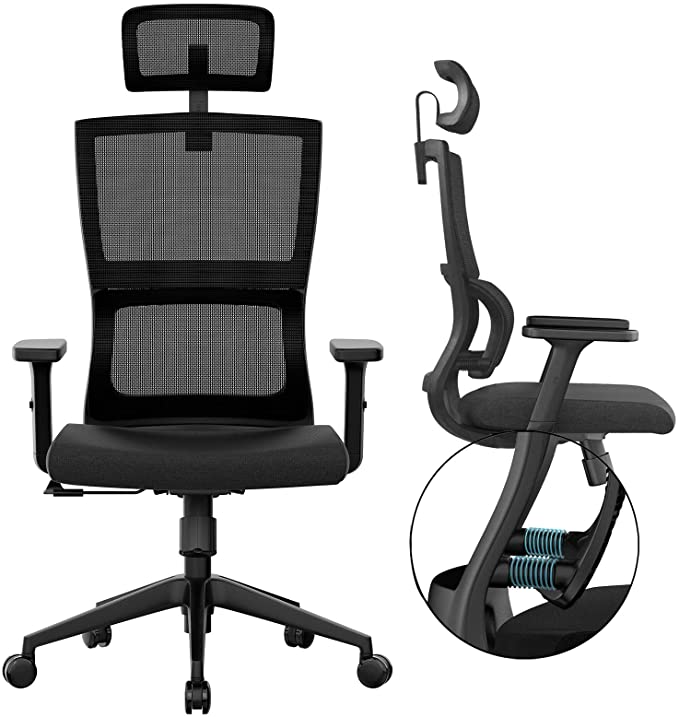How to Choose an Ergonomic Chair that Lasts (Maybe Forever)
Gaming chairs are still the de facto craze for DIY PC room setups. That being said, there has also been a growing awareness of the importance of ergonomic chairs within the last few years. The idea of maintaining good posture at all times, breaking all the bad sitting habits that you previously have. You know, those kinds of stuff. So how does one go about choosing an ergonomic chair that lasts?
More than simply discussing the features/elements of good ergonomic chairs, perhaps the more pressing question in light of its significance today, is how to find one that truly lasts. Because this is not just all about purchasing a random Herman Miller model and calling it a day (though sometimes it does).

Ergonomic Chair Longevity Tips Overview
Here is a quick look at how and what makes a good ergonomic chair that will also last.
- Watch that maximum weight
- Metal base all the way
- Yay for hard foam seats, hurray for mesh
- Nice n’ easy armrest cushion maintenance
- Protect your floor, check your rollers
- Footrests are overrated
Use the points below to help keep choose the best ergonomic chair.
1. Keep the maximum weight capacity far beyond your own
This is perhaps a no-brainer, given that you always need to have an overhead or allowance in most things that you need to use or adopt. In the case of office chairs, the weight allowance generally provides better user flexibility and ‘room’ for growth or other bigger users. Since you know, it might not be only you who is sitting on the chair exclusively, regardless of whether it is about another person sitting or the number of “entities” supporting the platform.
Another reason to check the maximum weight capacity is the time factor. Ergonomic chairs are typically purchased with the expectation that they would last a decade or two. And in terms of human years, a lot can happen within the chair’s decade of use. It’d be convenient for its extended service time if it has a lot of extra downward force capacity if some “event” pushes its base far harder more than when it was first bought. As it is quite common to grow sideways with age, the chosen chair needs to have that extra overhead to be able to take on the extra weight.
2. Just go for the metal base, and maybe graphite too if available
Cheaper, less sturdy chairs would often use some sort of hard plastic material to use as a base for the chair. This… is actually very acceptable. If we are talking about average weights, a mean value of about 200kg (440 lbs) max should be enough for the plastic base to withstand many years of use.
… But probably not an entire decade (or more) of use.
Metal bases, even those made of simpler reinforced aluminum, are going to be obviously better at maintaining tip number #1. Therefore, stepping down the solid material quality of a chair base in order to get a “thriftier base investment” for your ergonomic chair will never be worth it. The common consensus here is to just hold off the purchase and then get the higher quality choice later, after thoroughly double-checking the structure and composition of the metal base.
Oh, and in the same regard, graphite bases can be just as good as metal bases in terms of extreme longevity. Just keep in mind to still balance your budget accordingly with the models that do offer them.

3. Foamier seats are good, but mesh is the still the best
One way to easily see if an ergonomic chair is only ergonomic by visual design, is by checking seat itself. Most good quality ergonomic chairs will use a very hard foamy material, which is adequately soft yet tough enough to never budge from its form even while fully seated.
This is as opposed to standard cushions or hard plastic on lesser quality office chairs. Unlike the foamier seats, these would deform or stress out in time as you sit on them. In fact, some can flatten in just a matter of weeks or days, even pushing down as far as to expose your gluteus maximus to the metal underside.
But for the ultimate long-lasting ergonomic chair, find a model that uses mesh for all of its support and soft contact parts, including the seats themselves. These are usually guaranteed to last more than a decade, if not several decades, even with everyday, all-day-long use. But if you are not confident with the material, at least consider it for the backrest.
4. Make the armrest cushions easy to maintain
True, cushions on armrests adds comfort, but once you factor in the user’s bodily fluids in the equation, maintenance suddenly becomes a tricky subject. Of course, using an additional layer of removable cushion would be the easiest way to solve this, but… two things.
First, there is an additional investment cost for the ergonomic chair (in the form of these cushions). Second, the extra layer adds maintenance. You will need a spare pair to cycle through the cushions and clean them regularly.
As such, the better, more straightforward way to do cheap, easy maintenance on your ergonomic chair armrest, is to actually buy a model using those soft and durable, rubberized armrests. Naturally, you’ll eventually accumulate sweat on them as usual. But a simple wipe using a clean cloth dabbed with alcohol or diluted dish washing liquid is all that is needed to keep them squeaky clean.

5. Double-check the type of roller used for the ergonomic chair
Okay, this may be a tip from a bygone era of floor destroyers, but this is still quite prevalent among lower-quality chair builds tolday. Basically, you just need to check if there is some type of smooth bearing technology used for the rollers, and if each roller has a large enough size and tracking area to roll along near effortlessly.
Because, even if the chair itself would last for a decade, if the floor it is used on won’t last as long due to its scratching and nipping tendencies, the experience won’t still be as perfect. Besides, with such rough use over an extended time period, harder pushing/pulling forces would be the least of your problems.
If you have the opportunity to test this yourself (at a storefront, for example), you can try moving the chair using just one hand (pushing/pulling on tables, walls, etc.), with your feet above ground. If you can do this with relative ease, then it has passed the roller longevity test.
6. Footrests are unnecessary
Lastly, footrests are not exactly as convenient as they seem. While the luxury of extending your foot to stretch out and relax during breaks is enticing, it does not really help make the ergonomic chair any more “healthier” to use. Ever noticed the complete lack of footrests on some higher-end ergonomic chair models? If you really want to relax your legs after sitting in the correct ergonomic posture for so long, you can simply stand up and walk around for a bit, or take a short power nap and lie with your back straight.
In summary, footrests are basically overrated. Therefore, you don’t have to incorporate them in your ergonomic chair choice at all.

Search Ergonomic Office Chair on Amazon
BONUS: Lumbar Support
This point is crucial. As an ergonomic chair, it needs to not only support your derrier but your back, from top to bottom. The backrest needs to be sculptured to provide the best support and comfort for your back. It must also allow for fine tuning to offer the best lumbar support usually with a waist pillow. More expensive models may include shoulder and adjustable head rest. And, as we have mentioned in previous section, mesh office chair is one to go for. It offers three things, breathability, comfort and all round support. Together this not only ensures that you have trouble free use of the chair for years to come, that you are seated comfortably all the time.
Final Thoughts
As an additional note, going with reputable brands and using price ranges as a guide to get to the best ergonomic chairs is perfectly fine. Just remember to keep on researching for brand-exclusive features, as this would help boost your potential choices. Other features to look for when buying ergonomic chairs such as assembly choice, lumbar cushions, XYZ armrest adjustment, mesh-built back, colour options, memory foam are generally superficial. What you want is a proven or even patented design, manufacturer’s guarantee and warranty for up to 3 years or more and all the points we mentioned above.

Edited by Samuel J. Tan










